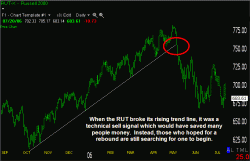Search Results for 'traders'
HOPE is Not a Trading Strategy

He is the Wiz, and nobody beats him.
It’s true – I’m a huge Market Wizards fan. All 3 of these interview-style trading books by Jack Schwager are excellent, and they continue to teach and remind me of highly important lessons about trading. My copies are all marked up with underlines, highlights, and margin notes, and I seem to add more every time I open them up.
Recently, I ran across a great quote by Larry Hite in Market Wizards:
“First, if you never bet your lifestyle, from a trading standpoint, nothing bad will ever happen to you. Second, if you know what the worst possible outcome is, it gives you tremendous freedom. The truth is that, while you can’t quantify reward, you can quantify risk.”
What a nice, basic concept. Know your risk…..on every trade, at any given time.
I know a trader who’s struggling to follow this advice right now. After getting caught on the wrong side of the market a few times in recent weeks, he’s suffered a series of tremendous setbacks. He isn’t quantifying his risk – now he’s only thinking of the rewards….praying he can recover from it quickly. As a result, he is swinging for the fences and hoping for a miracle. I’m afraid it’s just a matter of time before he’s right back to square one and looking for another trading stake. I’ve expressed my concern to him, but it’s a decision he’s going to have to make for himself.
HOPE is not a trading strategy! The market doesn’t care what side you’re on, and it has far greater staying power than you do. Arguing with the market is a futile endeavor, so the best we can do is to quantify our risk before putting trades on, and once our stop loss levels are hit we’ve gotta exit. The hard part isn’t knowing when you’re wrong (your P&L will tell you at all times). The hard part is replacing that hope of a miracle with the resolve to take action and stop losing (they call them ‘stop loss’ orders for a reason!).
It is easier to put a giant dent in your trading account when you’re trading with leverage. Futures, options, and even just day trading margin in a stock account can greatly accelerate losses compared to just trading a handful of stocks well within your buying power. Be sure you understand the risks you’re taking, because trading with leverage will compound your errors and bring the pain even faster.
We can all heed Hite’s advice, whether trading well or poorly. It’s timeless and it’s dead on. How can you argue with the idea of knowing your downside? You might be a part-time trader looking to make some extra cash on the side and possibly become a full-time trader one day. Or, you might already be a full-time trader. Regardless, the idea is to keep yourself in the game. Don’t blow out your account. Quantify your risk on every trade, and survive whatever the market throws at you. We’re all going to be wrong at times…..just don’t stay wrong when you know it’s time to bail out.
Jeff White
President, The Stock Bandit, Inc.
www.TheStockBandit.com
Find out how I quantify my risk here.
[tags]Stocks, Investing, Stock Trading, Trading, Stop Loss, Market Wizards[/tags]
How to Get Short
 On the heels of my order types post, I wanted to point out a useful tool to direct-access traders which only the more active day traders are likely to already know. Active traders who diversify are willing to trade both sides of the market, and aside from the uptick rule, getting filled on a short sale order is often the hardest part to catching the trade on the dark side.
On the heels of my order types post, I wanted to point out a useful tool to direct-access traders which only the more active day traders are likely to already know. Active traders who diversify are willing to trade both sides of the market, and aside from the uptick rule, getting filled on a short sale order is often the hardest part to catching the trade on the dark side.
Direct-access trading platforms offer hotkey choices to traders, allowing you to set up specific keys for sending out designated kinds of orders which are routed through your chosen venue. I have found that the ARCA market short/sell is probably my most valued hotkey for a couple of reasons. When I want out of a long position, I hit that key to send out a market sell order, regardless of whether I’m trading a listed stock or a Nasdaq stock. However, that same key is also the one I use when I am short selling a stock and need to enter the trade quickly. And fortunately for me, my trading platform automatically checks whether I’m already long, short, or flat so that I don’t need to set up different hotkeys for selling vs. short selling. For those of you hunting for the best direct-access broker, you might want to consider whether or not you’ll have to send out different order types for selling and shorting. Personally, I like to keep things simple!
The ARCA market short/sell is a proactive order, which means it will effectively ‘chase’ the market lower until either your order is filled or you cancel the order. On Nasdaq stocks, I find that using this key will get me into the trade almost instantly (it is scary fast), and on listed stocks (NYSE) it does a great job of helping me get filled when I want to get short.
Remember that short selling in a strong market can be tricky, but there’s still opportunities out there to catch pullbacks if you look for them in this environment. Once you find them, if you aren’t using the ARCA market short/sell order, you should be. It will make a world of difference to those of you who are willing to trade the short side.
Jeff White
President, The Stock Bandit, Inc.
www.TheStockBandit.com
[tags]Stocks, Investing, Stock Trading, Trading, Short Selling, Diversification[/tags]
Keep it Orderly
There are a lot of ways to buy and sell stocks these days, and virtually any kind of order you can think of is now available to traders. Because of my trading strategy, I’m often asked by subscribers of my swing trading service which order types I use to execute trades. The debate between Market & Limit Orders is an old one, but I’ve got pretty clear reasons for which type I prefer and when I use them. Let’s do a little Order Type 101 and look at some of the basics. Then I’ll wrap things up with a look at my personal preference.
Stop It!
I used to think that the most successful traders just knew how to locate the big winning trades and that was the key to their profitability.
Not anymore – I’m past that, and thankful that I finally realized it. It took some time, probably because of the irony of it all. Who would have thought that the best traders’ real key to consistent profits in the market all boils down to humility and their ability to get out of trades when they need to the most? What happened to bravado and having the guts to take the plunge and go big when you really feel you’re right? Is that not how the best traders do it?
Occasionally that approach might give you a windfall profit, but what happens when you’re wrong (and you WILL be)? If you don’t have an exit plan, you’re gonna be toast. It’ll be Hammer Time for your account, and it won’t be pretty or fun!
If you don’t respect the market, it will force you to respect it.
I’m a huge advocate of using stop loss orders, regardless of your operating timeframe. There are plenty of reasons to sell your stock, but the most basic premise is that once your trade stops behaving as you expected, it’s time to consider kicking it out the door.
3 Signs You Have a Pet Stock
One of my top 5 trading books is How I Made $2,000,000 in the Stock Market by Nicolas Darvas. From time to time I re-read this book because there are some good lessons and reminders in it. On page 11, Darvas refers to stocks he was trading in a funny way but one which all traders have been familiar with at one time or another:
“…For some of them I acquired a special liking. This came about for different reasons. Sometimes it was because they were given to me by a good friend of mine – other times, because I had started by making money with them. This led me to prefer these stocks more than others, and before I knew what I was doing I had started to keep ‘pets’.
I thought of them as something belonging to me, like members of my family. I praised their virtues day and night. I talked about them as one talks about his children. It did not bother me that no one else could see any special virtue in my pet stocks to distinguish them from any other stocks. This state of mind lasted until I realized that my pet stocks were causing me my heaviest losses.”
No doubt we’ve all encountered our share of “pet” stocks, but are you holding onto any of them right now? Here are three signs you may have a pet stock:
Keep it in Perspective
I just read Toddo’s latest post at MarketWatch and although I was already somewhat familiar with his story, reading it was 5 minutes very well spent.
He wrote it at a good time for a lot of traders caught on the wrong side of the market lately, so if that’s you be sure to check it out. His perspective is honest and clear….. “be careful what you wish for,” he even warns. At the end of the day, he’s dead right. Regardless of what you’ve made (or lost) as a trader, you’re going to need people by your side to make it even halfway worth while.
If you’re struggling right now, keep things in perspective.
One-Question Interview at StockTickr: Lessons I’ve Learned in the Downtrend
Big thanks to Dave over at StockTickr for his One-Question Interview with yours truly. Dave has interviewed me before, but this one focused on “What trading lessons I’ve learned from the downtrend that started in May,” so I was happy to oblige!
By the way, if you haven’t checked out StockTickr, you owe it to yourself to do so! It is a fantastic product and there are great updates made constantly as new ideas are implemented to provide users with even more useful trading tools, so it will be fun to see just what else it will be capable of providing as time goes on. There are also some great interviews at the StockTickr Blog which you’ll want to check out.
To expand a bit on the lessons I’ve been reminded of since May, let’s take them one at a time:
Shorts work faster than longs. Aside from my earliest days as a trader, I probably learned the most during the bear market from 2000-2003, actually doing rather well with my trading during that time. That period forced me to learn several methods of shorting stocks, and my education during that time has served me well the past couple of months. We have caught some great moves on the short side the past couple of months over at TheStockBandit.com which has allowed subscribers and me to continue finding profitable trades even though the market turned ugly. The biggest moves occur during bull markets, but some of the fastest profits come on the short side.
Trapped bulls sell into strength once the market tops out. This is what we’ve been seeing since May and even saw another round of it last week with a big rally followed by two more days of selling. Bulls who bought on the way down at perceived ‘value’ levels (valuation, schmaluation!) almost instantly saw their positions turn into losers, and as the downtrend continues it provides additional pain for them. Once a relief rally or even just a bounce begins, they are tempted to sell into the strength just to alleviate their pain and take smaller losses than what they had been facing. This essentially caps the upside of the market, and is why upside has been so limited the past couple of months.
Broken rising trend lines are significant technical events, and it’s wise to take notice whenever you see that happen. The RUT is a perfect example, as this small cap index had been leading the way during the spring making all-time highs in the process until the rising trend line was broken in May. That was a technical sell signal, and I pointed this out in The Bandit Broadcast stock newsletter when it occurred. The broken rising trend line didn’t so much start a bear market as it did end the bull run, so that was certainly a time to lighten up on long positions and start considering some short sales. It’s funny how few short candidates showed up on my screens prior to that event and how many there have been since then. That event shifted my trading bias significantly, so I’m fortunate to have placed such high importance on that trend line break. Here’s a chart with a look at the broken trend line:
Many traders lack discipline. This is not a new lesson, but I’ve recently been reminded of it. I have seen several people walk away from trading in recent weeks just because they’ve sustained losses in stocks which they refused to exit, hoping for a rebound that never came. HOPE is a 4-letter word! HOPE is not a trading strategy. If you find yourself hoping, you are wrong with at least your timing, and you’re most likely trading bigger than you should be. One other note on discipline I made to subscribers back in May is that once an uptrend ends and things begin to sour, your only logical choices are to go neutral (sit in cash) or get net short. Failing to abide by that basic principle has proved an expensive lesson for some these past two months, whereas the disciplined traders who have embraced that are sitting pretty.
The market won’t rally far without the NAZ. The NAZ has led the way lower, particularly the NAZ 100. In spite of the fact that the DJIA, RUT, and S&P 500 have all held up better than the NAZ, their upside will be limited without it. The NAZ used to be considered just a tech-heavy index that money would flow into and out of depending on the economy and modern advances. I think that now the world has changed and technology is now at the core of our world. Biotechs, semiconductors, and internets are among the most important sectors in our world today, and when those stocks trend down, it significantly handicaps the market. When those three important groups can start acting better, we’ll have much higher odds of a lasting market rally.
This market is acting a little better this week, but it’s still too early to declare that a turnaround has been made. Stay careful out there and keep in mind that even if a tradable low is being created here, it may not be smooth sailing on the way back up. If ever shortened timeframes were a good idea, it’s probably right now.
Jeff White
President, The Stock Bandit, Inc.
www.TheStockBandit.com
[tags]Stocks, Investing, Stock Trading, Technical Analysis, Trading Psychology[/tags]







